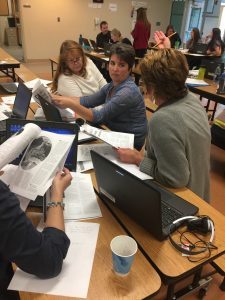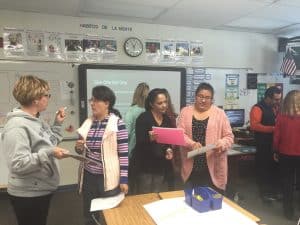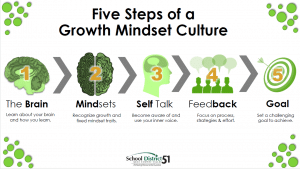Supporting Teachers at D51: A Conversation with the Professional Learning Facilitators
CompetencyWorks Blog
 This article is the seventh in the Designing Performance-Based Learning at D51 series. A reminder: D51 uses the phrase performance-based learning or P-BL.
This article is the seventh in the Designing Performance-Based Learning at D51 series. A reminder: D51 uses the phrase performance-based learning or P-BL.
Leigh Grasso, Director of Academic Achievement & Growth at D51, emphasizes, “We are shifting from a focus on professional development to professional learning.” And there are a lot of people focusing on helping the adults in the system learn. In the district decision-making/communication structure, there is the Learning System Support Team (LSST) that includes Content Facilitators (CFs). There is also the team of Professional Learning Facilitators (PLFs) who are organizing Design Labs for teachers.
I had the opportunity to speak with some of the PLFs, Amy Shephard-Fowler, Heather Flick, and Bil Pfaffendorf. As part of the Learning System Support Team, they are charged with creating and managing the overall the overall design for the structure of professional learning opportunities such as design hubs but work collaboratively with other LSST members, teachers, and administration in the design of the content to support the implementation of the performance-based system.
Background
As explained to me, D51 didn’t have a lot of systematic professional development in previous years. Four days a year were dedicated to event professional development with little choice available to teachers. In 2009 -2010, D51 completed the Comprehensive Appraisal for District Improvement (CADI) process and, in so doing, the emphasis on pedagogy went to an extreme emphasis on regimented delivery of curriculum and direct instruction. This left some teachers feeling like they had little autonomy and as if they had limited flexibility to meet the needs of their students. Flick explained, “We have the perfect storm to bring performance-based learning to the Grand Valley. They are ready for a system that is focused on our students.”
Feedback: The Key to Continuous Improvement for Designing Professional Learning
In considering the new strategy, the LSST wanted to embrace the same values that undergird P-BL: transparency, empowerment, voice, choice, relevance, and meeting people where they are. It was important to design for opportunities for voice and choice. Teachers had not had ongoing opportunity to voice opinions, either negative or positive, so creating transparency in the system was an important part in the design. It was also going to be important to make sure that the teachers knew the LSSTs were not only listening but responding to their opinions. The professional learning system needed to generate trust if teachers were going to feel safe taking risks and changing practices.
The team had gone to a Learning Forward conference to learn more about how to build learning communities. (A bit of context: Many years in the past, they had invested in the Dufour model of “professional learning communities.” To reinvigorate that capacity, they are drawing from Learning Forward and using the phrase “learning communities.”) One of the most important tips they brought back was on how to generate productive feedback. It’s simple: Make sure you use the feedback.
Shepherd-Fowler explained, “We used to ask for open feedback and much of it wasn’t very useful. When we started sharing the feedback with teachers and describing how we made adjustments based on it, the feedback became much more useful. We now use feedback protocols for everything we do. It helps teachers think about the type of feedback they are giving and they are confident that we will consider it for improving professional learning.”
There was also a shift to include more staff in the design and implementation of professional learning. Calls for proposals went out in designing the professional learning days. However, they learned that offering more voice and choice isn’t enough. There has to be a clear purpose. Shephard-Fowler recalled, “When we just asked teachers to submit proposals for presentations, we had a large range of topics and practices. There were a lot of options for teachers, but overall it was hit and miss in terms of driving a transformation in the district. So the next year we organized it under Tools for Transformation.” Flick added, “We understood that we were not going to change practice unless we were more clear about the purpose.”
Thus, the next year, they organized the professional learning and the call for proposals under Tools for Transformation. They also began to coach teachers who were presenting in adult education (based on andragogy, the adult learning theory of Malcolm Knowles), introducing the very same concepts of growth mindset, personalization, relevance, transferability, and presentation skills. As a result, D51 is building their cadre of trainers who will be able to coach other trainers as the demand for professional learning increases.
Design Labs
 D51 uses the term Design Labs to describe the professional learning sessions on the core concepts and skills related to the transition to P-BL. Rebecca Midles, Executive Director of Performance-Based Systems, emphasized this point with, “Designing is empowering. We all stay empowered when we think we can design, and change, the world around us.” Shepherd-Fowler enthusiastically agreed. “Design is the teaching, learning, and assessment cycle,” she said. “Kids can take this same process – where are we, what are the ideas, let’s try this one – and take it back to an authentic audience to get feedback. By introducing design thinking into the core of the pedagogy, we are laying the foundation for students to become independent learners.”
D51 uses the term Design Labs to describe the professional learning sessions on the core concepts and skills related to the transition to P-BL. Rebecca Midles, Executive Director of Performance-Based Systems, emphasized this point with, “Designing is empowering. We all stay empowered when we think we can design, and change, the world around us.” Shepherd-Fowler enthusiastically agreed. “Design is the teaching, learning, and assessment cycle,” she said. “Kids can take this same process – where are we, what are the ideas, let’s try this one – and take it back to an authentic audience to get feedback. By introducing design thinking into the core of the pedagogy, we are laying the foundation for students to become independent learners.”
She described their approach as “contextualized design thinking” that is very clear on the context of the learners and the end result. Some might call it strategic design thinking. They’ve drawn a bit from Stanford’s approach as well as the design thinking processes promoted at the Colorado Education Initiative.
Flick emphasized, “If you want to personalize professional learning, you are going to end up using design thinking to do it. There just isn’t any way you can actually meet people where they are AND get to where you want to go. Our design process is completely iterative, as we are designing within a context of the culture of a growth mindset, effective practices to support more agency and independence in our learners, and, eventually, the graduate competencies based on the graduate profile the community is creating.”
Currently, there are five offerings of Design Labs in 2016-17, organized around three themes:
- Culture (Social & Emotional Learning and Growth Mindset);
- Learner-Centered Environment (Backward by Design; Shared Vision & Code of Cooperation; and Workshop); and
- Transparency (Assessment for Learning & Rubrics).
The instructional design is the workshop for all models so that teachers get a feel for how it can look and how the facilitators manage the learners. As Flick pointed out, “The Design Labs are the foundational effective practices. If teachers don’t have these skills, they can do P-BL.” Shepherd-Fowler added, “We are constantly helping to make the connections across these practices. The key is for teachers to work with them enough that they become routines. If every classroom uses these practices, then we will reach a point where this becomes systemic.”
At this point, the LSST has drafted a Learning Continuum for each of the Design Lab modules, running from emerging and exploring to applying and refining. (see Growth Mindset Learning Continuum). There are indicators for each of the five strands of the Growth Mindset: the brain, understanding mindsets, self-talk, growth feedback, and goal-setting.

The indicators might be written about the behavior of the facilitator (teacher) or the student. The other learning continuums developed to date (they will be expanding modules and learning continuums as they move farther into implementation) include Assessment for Learning (data-driven planning & instruction, data transparency, and data artistry); Shared Vision/Codes of Cooperation/Standard Operating Procedures (what I like to think about as part of the practices for student agency); Backward by Design (identify desired results, determine acceptable evidence, and plan learning experience and instruction); and Workshop for All (physical environment, focus lesson, work time in the discipline, small group instruction, productive group work, conferring, and closure/reflection).
The modules and the continuums mean that professional learning can become more personalized and teachers can eventually become more independent in their learning. In current professional learning sessions, you might walk into a room with 120 teachers, where some are clustered together learning about the adolescent brain and others on self-talk. The PLFs hope to continue to personalize the modules, as not every teacher will learn in the same way and reactions to instructional materials will vary. They are also hoping at some point to be able to put the modules online so they are available 24/7. This will also help with the issue of scaling professional learning so that all 1,500 teachers have access when they are ready for the next step.
Shepherd-Fowler noted, “We are now getting to the point where there are teachers in the demonstration schools who have spent time in every design lab. They are motivated by their own interests to introduce these practices into their classroom because they are seeing that they are making a difference.” Flick continued, “They are starting to see the intersections and make the connections. These moments of connection are truly cathartic. If they don’t have a growth mindset, will they be able to take advantage of growth producing feedback? If we don’t have standard operating procedures that help them be more independent in getting their questions answered, how am I going to run workshop?”
Tips for Designing Professional Learning

What would the professional learning advisors recommend to other districts getting started?
- Meet Teachers Where They Are: Always ask teachers what they need.
- Use Feedback to Build Trust and Accountability: Be transparent with your feedback. Intentionally share the feedback from teachers and show how you used their feedback. In other words, hold yourself accountable.
- Include Transferability: Professional learning has to be clear about how it can be used in the classroom. This requires making it explicit, using the practices, and modeling them for teachers. Tools need to help teachers and also be examples of what classroom tools might look like.
- Make Connections: Don’t assume teachers learning new practices are going to make connections. Intentionally make the connections.
- Be Prepared for a Variety of Learning Styles: Remember that teachers will have different styles and pacing of learning. Some will take small bites and practice until they feel confident before taking another bite. “Omnivores” may go after new ideas until they are overloaded, at which point they will back off, cool down, and then throw themselves back in.
Flick emphasized, “It’s all about trust. The learning continua are building a pathway for every teacher to have the skills to succeed in P-BL. We are holding ourselves accountable that we are doing P-BL as we teach about P-BL.”
Embedding Professional Learning in Schools
Another strand of work is to revitalize the learning communities. D51 had previously used the Dafour model of professional learning communities, but over the years it had become stagnant. They are now revitalizing them using the Learning Forward model. They are using a learning continuum, starting with three traits of effective learning communities (with the likelihood that they will expand over time to additional traits). They are adamant that these continuums should not be used as evaluative, only growth-producing.
The hope is that the focus on professional learning communities will help site leaders become stronger instructional leaders, a critical role in P-BL, especially when the system is in place and everyone moves into an urgent need for continuous improvement.
The seven criteria or traits of the Learning Forward learning continuum are:
Working Agreements: Agreed upon norms and expectations for behaving and operating in our LC
Goal/Focus: Agreed upon direction, working towards specific outcomes for students and adults
Sharing Practices: Sharing successes and struggles of one’s own professional practice
Collaboration: Working together to develop a shared understanding and common assessments
Depth of Conversations: Deep conversation about student work that focuses o success for each student
Data Collection/Analysis: Process of collecting data for the purpose of improving practice
Intervention: Actions to be taken for students who are not successful or challenged are identified, implemented, assessed and adjusted as necessary.
More Intensive Learning Opportunities
As noted, the district has minimal days for professional learning: high schools have two and a half days; middle schools have four; and elementary schools a little more than nine days. The district is adding on optional learning opportunities, including a Summer Institute and a three-day conference called Elevate. Last summer, 400 educators attended, with sessions led by Bill Zima and Lori Lodge from Maine. By holding a conference and bringing in P-BL leaders from other parts of the country, D51 is minimizing their geographic isolation, tapping into expertise, and lifting themselves to a national leadership role.
Read the Entire Series:
Post #1 – Designing Performance-Based Learning at D51
Post #2 – Building Consensus for Change at D51
Post #3 – The Vision of Performance-Based Education at D51
Post #4 – Holacracy: Organizing for Change at D51
Post #5 – Growing into the Framework: D51’s Implementation Strategy